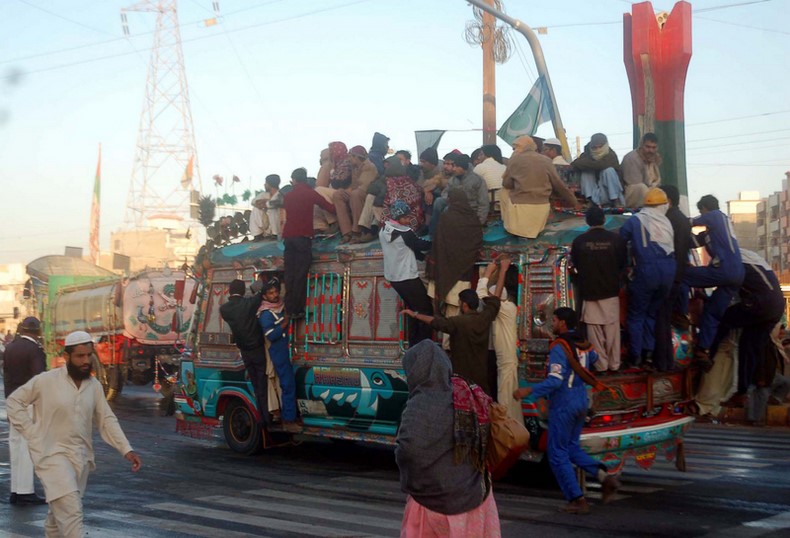
People queue with their vehicles in front of a compressed natural gas filling station. Image by Jamal Dawoodpoto Copyright Demotix (24/9/2013)
About 1.3 million people live without electricity, and one-third of them live in Asia and Pacific, according to the United Nations. Pakistan, marred by a deteriorating economy and security situation, is one of the countries facing a severe energy shortage. Khawaja Muhammad Asif, Pakistan’s Minister for Water and Power, calls the country's energy crisis “a bigger challenge than even terrorism”.
The Iran-Pakistan gas pipeline project, currently under construction, aims to help fix the situation. But the project hit a serious snag in early December when Iran cancelled a loan worth 500 million US dollars to help Pakistan finance its part of the pipeline. Former President Mahmoud Ahmadinejad had promised the money, but Iran's oil authorities now say they don't have the funds, especially after pumping two billion US dollars into their own part of the pipeline.
The cancelled loan could jeopardize the timeliness of the project's completion, which would be disastrous for Pakistan in itself: a penalty clause in the two countries’ agreement stipulates that withdrawing or delaying the pipeline will result in a daily fine of up to three million US dollars.
National interests are supreme to every nation. RT”@yasmeen_9: Iran cancels IP gas pipeline loan. http://t.co/8UOlr1MCtR via @sharethis“
— Altaf Sheikh (@redmax_) December 14, 2013
Iran's decision has been a devastating blow to Pakistan, but officials are still determined to forge ahead with the project, for which half the work has already been completed. Following Iran's suggestion, Pakistan is looking to European firms to help with the financing or even act as a middleman and sell the gas to Pakistan, while an Iranian construction company has offered to fund the Pakistani side of the pipeline, but would need the green light from the Iranian government.
Very bad news. #Iran Cancels #Pakistan Gas Pipeline Loan – ABC News http://t.co/LL6jZ7fp08 (via @ABC)
— farahnaz ispahani (@fispahani) December 14, 2013
One of the major impediments to the pipeline for Pakistan has been international sanctions against Iran. The US especially has warned Pakistan to back down on the project and advised the country to utilize Central Asian routes instead. As a result of this immense pressure, unavailability of financing, and to appease the US, Pakistan has also been aggressively pursuing the Turkemanistan-Afghanistan-Pakistan pipeline, which is scheduled to be completed in 2017.
However, according to Pakistani Prime Minister Nawaz Sharif, the country is up against a wall when it comes to energy:
“The US must consider that we’re going through a very tough time . . . We do not have choices. If the international community doesn’t want us to deal with the Iranians then they should have given us some alternatives.”
The Iran-Pakistan pipeline was inaugurated on 11 March 2013 by then Presidents Asif Ali Zardari and Ahmadinejad, for the purpose of providing gas supply for the production of electricity and meeting other energy needs. A brain child of Malik Aftab Ahmed Khan, the idea originally was for an Iran-Pakistan-India pipeline to transport gas to India and Pakistan from Iran, which has the world's largest reservoir of natural gas.
The project is forecast to bring about savings of around 2.4 billion US dollars by replacing furnace oil-run units with the imported gas. As the nation depends on gas due to the influx of cars that run on compressed natural gas (CNG), there has been extreme demand on the individual level in addition to household consumption. Around 65 percent of the CNG stations have remain closed in Punjab for three months starting in November 2013. The situation is further exacerbated in the fertilizer sector, which has experienced extreme shortages of gas and suffered heavy losses.

Passengers travel on an overloaded bus during a transportation shortage due to a lack of compressed natural gas (CNG)in Karachi, Pakistan. Image by ppiimages Copyright Demotix (2/1/2013)
Former member of Pakistan's Parliament, Senate and National Assembly Sana Baloch commented on the cancelled loan on his Twitter account:
Very blunt diplomatic slap. Iran cancels Pakistan gas pipeline loan http://t.co/csn41AFhfv
— Sana BALOCH (@Senator_Baloch) December 14, 2013
Pakistan People's Party member Malik M Ali Awan replied:
@Senator_Baloch Pakistan should stand with Nato powers in dealing with Iran. More friendlier close relations r not good for Pakistan.
— Malik M Ali Awan (@MalikMAliAwan1) December 14, 2013
Commenting on a story about the cancellation on Pakistani news website Dawn, user “shirin” argued:
If its in Pakistan's interest to have the pipeline built, it needs to come up with 2bn and stand up to US and its sanctions that hurt Pakistan's interest.
User “independentthinker” chastised Pakistani leadership:
Why would Pakistan even consider entering into any contract when a) it doesn't have the means to finance it and b) the other party (Iran) is facing severe sanctions from the West and it is very possible, Pakistan can face serious repercussion from the U.S., if it carried through? It amazes me how our politicians think […]
It is expected that in order to meet the surging demand for gas, concrete action will be taken by the government despite the ramifications of the project. It could be done via engaging Iran in bilateral trade or negotiating for a deferred payment on the project. Otherwise, Pakistan should be prepared to pay the hefty penalty per day and possibly face wave of strikes, violence and discord again in 2014.






